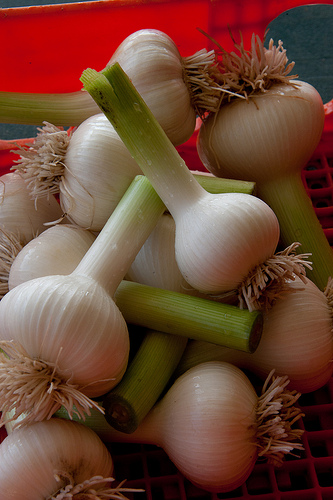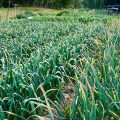Garlic (Allium sativum) has long been used as a culinary spice and medicinal herb. It is believed to have originated in Central Asia for over 5,000 years ago. Its fine aroma and distinct taste make garlic an export winner crop. There are about 300 varieties of garlic all over the world. Garlic is classified based on its origin and morphological features. Several types of garlic include: true garlic (predominantly from China), hard neck varieties (Asiatic types) and soft neck varieties. In the Philippines, the varieties of garlic being planted fall under the soft neck varieties that are often cultivated in the provinces of Ilocos, Batanes, Mindoro, and Batangas. Aside from its versatility as a culinary bulb, garlic production provides a wide range of livelihood and economic opportunities for the Filipino farmers.

Land Preparation and Planting
Garlic can be grown on a wide range of soil types. The soil should be harrowed thoroughly to break large soil clods and eliminate the growth of perennial weeds. Heavy soil types may hinder bulb expansion that would result to rough and irregular shaped bulbs. Soil pH should range from 6.0-7.5. Apply organic matter such as animal and green manure to the soil prior to planting.
Garlic seed stock should be stored as whole bulbs prior to planting. It should not be stored long, since cloves separate from the parent bulb deteriorate rapidly. The amount of planting material may vary from 700-1,000 kg/ha, depending upon the weight of individual cloves to be planted and planting space. The distance of the planting holes ranges from 7-12 cm apart. Cloves of small-bulbed strains may be planted as close as 7 cm apart. Single or multiple rows are commonly used. Spacing between rows is generally not less than 20 cm.
Fertilizer Application
Garlic grows well on fertile soil. The amount of nitrogen fertilizer required varies depending on soil type. Garlic generally requires 70-125 kg/ha. of nitrogen. A small amount of nitrogen can be applied as soon as the primary leaves sprout from the bulb. The application of nitrogen fertilizer should be completed within 4-6 weeks before harvest. Optimum care must be taken when applying the fertilizer to avoid foliar burn. Applications of urea should be avoided for it may cause plant injury.
Irrigation
Garlic is sensitive to moisture stress throughout the growing season. For most soils, 2.5 cm of water is required per week during growing season. Morning to mid-afternoon is the best time of irrigation. This allows sufficient time for the foliage to dry before nightfall. As the garlic matures, watering is minimized to avoid bulb deterioration.
Garlic diseases
The major disease problems that infest garlic are fusarium basal rot and penicillium mold. Fusarium basal rot is a disease that attacks the basal plate region and the roots. Warm soil temperature and high moisture content in the soil trigger the growth and development of the soil-borne pathogens. Crop rotation is found helpful in preventing the fusarium basal rot.
Penicillium mold is the main cause of garlic decay while in storage. The disease appears as masses of blue-green spores and usually attacks the base of the bulb. The planting of garlic during the later part of summer when temperature is quite high should be avoided. This favors the development of pathogens that cause clove rot. Irrigation may help during the early stage of planting, since soil moisture content appears to suppress clove rot.
Harvesting and Curing
It is easy to detect when garlic cloves are ready for harvest. Matured leaves begin to dry, discolor and bend towards the ground. Another indication of bulb maturity is the reduced thickness of leaf sheath surrounding the bulb. Garlic may be harvested by hand pulling. Using a fork helps loosen the soil thus facilitate lifting. Harvested garlic must be cured properly to ensure a long storage life. Open field curing may be done by placing the garlic in vegetable bins with cover but this should allow natural air to dry the cloves. In indoor curing, garlic gloves are placed in wired racks or open trays. The storage house should be well ventilated.
—————————————
Source:
Veggies Today, National Vegetable RDE Network, Institute of Plant Breeding, UPLB College, Laguna, Tel no. (049)536-2512 local 217; Ontario FactSheet, Ministry of Agriculture, Ontario, Canada)
By: Mary Charlotte O. Fresco, BAR Digest, April-June 2001 Issue (Vol. 3 No.2)






